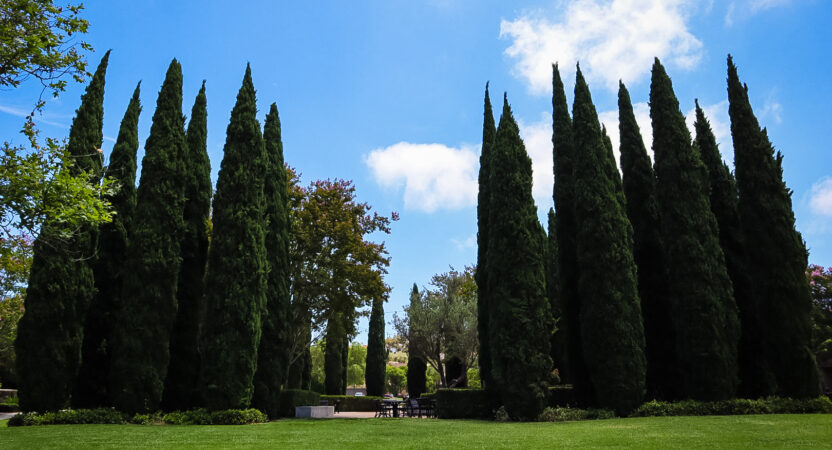All About Trees
Trees are beyond beneficial – they provide oxygen, lend to clean water supply, regulate temperatures, support wildlife habitats, minimize flooding, reduce crime, improve health and overall mental well-being, and increase property value – just to name a few! Here are a few helpful tips on getting the most out of your tree investment. A healthy tree is a happy tree!
Tree placement is a critical aspect of a tree’s overall health and ability to mature and thrive. There are several factors to consider:
- What goal are you trying to accomplish?
- Consider all viewpoints – where will the tree provide shade, be a focal point, or will it block a view when mature?
- Does your property have areas that receive too much sunlight or wind?
- Are there areas in need of screening or privacy?
- Always consider the proximity of your newly planted trees to buildings, structures, entrances, and walkways; planting trees too close could hinder their growth, interfere with common areas, increase maintenance (trimming) needs, and result in long-term root intrusion damage to structures and hardscape.
- Also consider the trees’ size at full maturity and growth rate. Overcrowding trees is a common mistake in commercial landscaping, to accomplish short-term goals – but the long-term result could be detrimental to the trees’ health.
- Moving a mature tree is much more costly and time consuming than just having to move a small shrub! So, selecting the appropriate spot to plant it is critical.
Tree species and size are two other important aspect in the tree selection and placement process. It’s important that your trees are well-suited for your property’s overall landscape design but also for the climate. Locally-grown trees are often selected by your landscape contractor, for a few reasons – they’re acclimated to the climate, they can be hand-picked, and they undergo an easy delivery process – a healthy start for your trees, ensuring long-term growth!
Additionally, you want to select trees that serve a purpose: do they accomplish design goals, do they provide adequate shade and/or privacy at maturity, and do they add color or visual appeal? Are they deciduous or evergreen? Deciduous trees shed their leaves at the end of their growing season (requiring more cleanup and maintenance) whereas evergreens keep their foliage (all or most) year-round.
You also want to consider the added value the tree investment will add to your property and at what rate they will grow. If you’re looking for an immediate impact, you may opt for more mature trees (more costly) versus smaller trees that will take more time to establish and grow.
It’s equally as important to be aware of the diseases and pests that your new trees are susceptible to. Tree installation is a large investment; you want to ensure that investment is protected from pests and/or disease that can cause damage and inhibit growth. For example, palm weevils can cause serious damage to palm tree species and even kill the plants. Polyphagous Shot Hole Borer beetles are another damage-causing beetle we’re seeing now that bore tiny tunnels into tree trunks, creating fungus to feed their larvae. This process eventually kills the trees. It’s important that your landscape contractor has a good understanding of tree diseases and pests, at the time of installation and throughout the maintenance process (having a certified arborist on staff is a plus!), to avoid infestations and/or treat any issues that may arise – to avoid costly replacements.
Tree watering and water needs is a key component in the long-term health of your trees and plays a factor in your landscape budget; if you want to keep costs down, consider selecting trees for your property that don’t require a lot of water – such as drought-tolerant options. Regardless of the type of tree, giving it the adequate water it needs to thrive is critical. For example, a bubbler system can be more beneficial for trees versus overhead spray, which may not allow water to penetrate the soil deep enough – causing surface roots. Your maintenance provider will establish the appropriate irrigation components and schedule needed for optimal success – ensuring your trees are getting the water they need to keep them healthy.
Another factor to consider in your overall maintenance budget and to maximize your property’s tree health is tree trimming or pruning. This involves removing unhealthy growth to promote new, healthier growth. The trimming process keeps trees strong, makes them less susceptible to pests and disease, allows for better light and air circulation, and influences growth patterns. It’s also important to maintain a safe environment for your employees and customers.
Now that you’ve selected your trees, decided where they should be planted, addressed pest issues, and determined watering and trimming requirements – it’s time to think about the trees’ fertilization needs. Young trees, depending on the species, may need to be fertilized more frequently – annually or more – to promote growth. More mature trees may need to be fertilized less – such as every 2 to 3 years – to maintain health. Different fertilizers provide different things for the plants; some are more for the roots while others promote more growth or flowering.
Have more tree questions? Reach out to your account manager or one of our knowledgeable team members today. We’re here to offer suggestions and recommendations, suited to your property’s specific goals and budget, to ensure your trees are healthy and thriving – whether it’s for ongoing maintenance, a new installation, or a landscape renovation.

